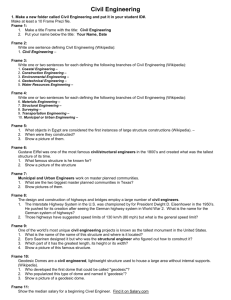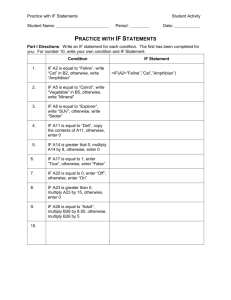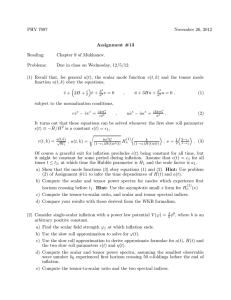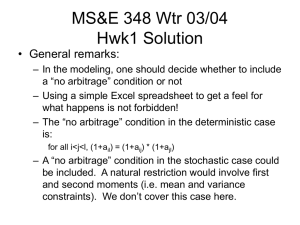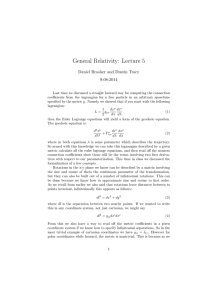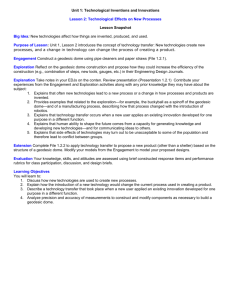GEODESIC GRAPHS ON SPECIAL 7-DIMENSIONAL G.O. MANIFOLDS
advertisement
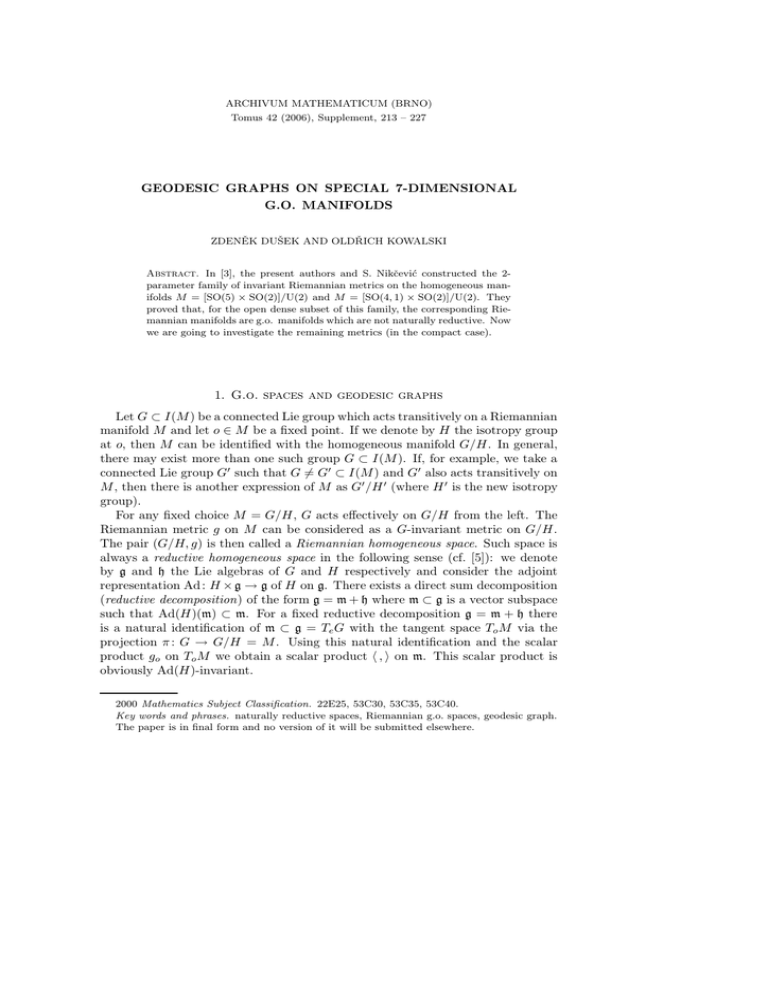
ARCHIVUM MATHEMATICUM (BRNO)
Tomus 42 (2006), Supplement, 213 – 227
GEODESIC GRAPHS ON SPECIAL 7-DIMENSIONAL
G.O. MANIFOLDS
ZDENĚK DUŠEK AND OLDŘICH KOWALSKI
Abstract. In [3], the present authors and S. Nikčević constructed the 2parameter family of invariant Riemannian metrics on the homogeneous manifolds M = [SO(5) × SO(2)]/U(2) and M = [SO(4, 1) × SO(2)]/U(2). They
proved that, for the open dense subset of this family, the corresponding Riemannian manifolds are g.o. manifolds which are not naturally reductive. Now
we are going to investigate the remaining metrics (in the compact case).
1. G.o. spaces and geodesic graphs
Let G ⊂ I(M ) be a connected Lie group which acts transitively on a Riemannian
manifold M and let o ∈ M be a fixed point. If we denote by H the isotropy group
at o, then M can be identified with the homogeneous manifold G/H. In general,
there may exist more than one such group G ⊂ I(M ). If, for example, we take a
connected Lie group G′ such that G 6= G′ ⊂ I(M ) and G′ also acts transitively on
M , then there is another expression of M as G′ /H ′ (where H ′ is the new isotropy
group).
For any fixed choice M = G/H, G acts effectively on G/H from the left. The
Riemannian metric g on M can be considered as a G-invariant metric on G/H.
The pair (G/H, g) is then called a Riemannian homogeneous space. Such space is
always a reductive homogeneous space in the following sense (cf. [5]): we denote
by g and h the Lie algebras of G and H respectively and consider the adjoint
representation Ad : H × g → g of H on g. There exists a direct sum decomposition
(reductive decomposition) of the form g = m + h where m ⊂ g is a vector subspace
such that Ad(H)(m) ⊂ m. For a fixed reductive decomposition g = m + h there
is a natural identification of m ⊂ g = Te G with the tangent space To M via the
projection π : G → G/H = M . Using this natural identification and the scalar
product go on To M we obtain a scalar product h , i on m. This scalar product is
obviously Ad(H)-invariant.
2000 Mathematics Subject Classification. 22E25, 53C30, 53C35, 53C40.
Key words and phrases. naturally reductive spaces, Riemannian g.o. spaces, geodesic graph.
The paper is in final form and no version of it will be submitted elsewhere.
214
Z. DUŠEK, O. KOWALSKI
Definition 1.1. A Riemannian homogeneous space (G/H, g) is said to be naturally reductive if there exists a reductive decomposition g = h + m of g satisfying
the condition
(1)
h[X, Z]m , Y i + hX, [Z, Y ]m i = 0
for all X, Y, Z ∈ m .
Here the subscript m indicates the projection of an element of g into m.
It is also well-known that the condition (1) is equivalent to the following more
geometrical property:
(2)
The curve exp(tX)(o) is a geodesic for all X ∈ m .
Definition 1.2. Let (M, g) be a homogeneous Riemannian manifold. Then (M, g)
is said to be naturally reductive if there is a transitive group G of isometries for
which the corresponding Riemannian homogeneous space (G/H, g) is naturally
reductive in the sense of Definition 1.1.
Examples are known such that M = G/H is not naturally reductive for some small
group G ⊂ I0 (M ) but it becomes naturally reductive if we write M = G′ /H ′ for
a bigger group of isometries G′ ⊂ I0 (M ). By the straightforward generalization of
the property (2) we get the following definition.
Definition 1.3. A Riemannian homogeneous space (G/H, g) is called a g.o. space
if each geodesic of (G/H, g) (with respect to the Riemannian connection) is an orbit
of a one-parameter subgroup {exp(tZ)}, Z ∈ g, of the group of isometries G. A
homogeneous Riemannian manifold (M, g) is called a Riemannian g.o. manifold if
each geodesic of (M, g) is an orbit of a one-parameter group of isometries.
For more information about the relation between naturally reductive spaces and
g.o. spaces and also for the references to related topics see [3].
Our technique used for the characterization of Riemannian g.o. spaces and g.o.
manifolds is based on the concept of “geodesic graph”. The original idea (not
using any explicit name) comes from J. Szenthe [9].
Definition 1.4. Let (G/H, g) be a g.o. space. A vector Z ∈ g is called a geodesic
vector if the curve exp(tZ)(o) is a geodesic.
Definition 1.5. Let (G/H, g) be a g.o. space and g = m + h an Ad(H)-invariant
decomposition of the Lie algebra g. A (general ) geodesic graph is an Ad(H)equivariant map η : m → h which is rational on an open dense subset of m and
such that X + η(X) is a geodesic vector for each X ∈ m.
On every Riemannian g.o. space (G/H, g) there exists at least one geodesic graph.
The constuction of the canonical geodesic graph and general geodesic graphs is
described in details in [3], [6], [7]. The components ηi of a geodesic graph are
always rational functions in the form ηi = Pi /P , where Pi and P are homogeneous
polynomials (of the coordinates on To (M )) and deg(Pj ) = deg(P ) + 1. The degree
of a geodesic graph is defined as the degree of the denominator P in the situation
when Pi and P are relatively prime.
GEODESIC GRAPHS ON SPECIAL 7-DIMENSIONAL G.O. MANIFOLDS
215
Definition 1.6. If (M, g) is a g.o. manifold, then the degree of (M, g) is the
minimum of degrees of all geodesic graphs (either canonical or general ) constructed
for all possible g.o. spaces (G/H, g) where G ⊂ I0 (M ) and M = G/H.
According to the results of J. Szenthe, the degree of (M, g) is zero if and only
if (M, g) can be made a naturally reductive space (G/H, g) for a suitable choice
G ⊂ I0 (M ).
For the examples of geodesic graphs of various degrees ve refer to [6], [7], [1], [2].
The systematic description of temporary results was given in [3].
2. G.o. spaces in dimension 7
First, let us quote explicitly the main result of [3], Proposition 1.6.
Proposition 2.1. On a homogeneous space G/H = (SO(5) × SO (2))/U(2) (or
G/H = (SO(4, 1) × SO (2))/U(2), respectively) there is a family {gp,q } of invariant
metrics depending on two parameters p > 0, q > 0 (or p > 0, q < 0, respectively)
with the following properties:
(A) If p, q satisfy the system of inequalities
(3)
p 6= 2 ,
q 2 6= 4p2
1−p
,
2+p
q 2 6= 2p3
6−p
,
3p2 + 4
q 2 6= p2 ,
then G is the maximal connected group of isometries of (G/H, gp,q ).
(B) If p, q satisfy the inequality p 6= 1, then (G/H, gp,q ) is a Riemannian g.o.
space which is not naturally reductive; for p = 1 it is naturally reductive.
(C) If p, q satisfy the inequalities
(4)
p 6= 2 ,
q 2 6= p2 (2 − p) ,
q 2 6= 4 (p − 2)2 ,
then (G/H, gp,q ) is locally irreducible.
(D) The group SO(5) (or SO(4, 1), respectively) acts as a transitive group of
isometries on (G/H, gp,q ) but the corresponding Riemannian homogeneous space
(SO(5)/SU(2), gp,q ) (or (SO(4, 1)/SU(2), gp,q ), respectively) is never a g.o. space.
Let us recall the construction of the examples in [3] at the Lie algebra level. Let m
be a 7-dimensional vector space with the (positive) scalar product h , i. Choose an
orthonormal basis (E1 , . . . , E4 , Z1 , Z2 , Z3 ) in m. We denote v = span(E1 , . . . , E4 ),
z = span(Z1 , Z2 , Z3 ) and thus m = v+z. Further we denote Aij (for 1 ≤ i < j ≤ 4)
the elements of so(v), Bαβ (for 1 ≤ α < β ≤ 3) the elements from so(z) and Ciα
(for 1 ≤ i ≤ 4 and 1 ≤ α ≤ 3) the elements from so(m) with the corresponding
216
Z. DUŠEK, O. KOWALSKI
action given by the formulas
Aij (Ek ) = δik Ej − δjk Ei ,
(5)
Bαβ (Zγ ) = δαγ Zβ − δβγ Zα ,
Ciα (Ej ) = δij Zα , Ciα (Zβ ) = −δαβ Ei
(for
i, j, k = 1, . . . , 4
and α, β, γ = 1, . . . , 3) .
We consider now the algebra h = span(A, B, C, D) ≃ u(2), where
(6)
A = A34 − A12 ,
B = A13 + A24 ,
C = A14 − A23 ,
D = 2 B12 + A14 + A23
and we put g = m + h. Now we define the Lie algebra structure on g by the
additional relations
[E1 , E2 ] = p(Z1 − A) , [E2 , E3 ] = qZ3 − pC ,
[E1 , E3 ] = p(Z2 + B) ,
(7)
[E2 , E4 ] = −p(Z2 − B) ,
[E1 , E4 ] = qZ3 + pC ,
[E3 , E4 ] = p(Z1 + A) ,
2q
2p
2p
[Z1 , Z2 ] = Z3 , [Z2 , Z3 ] =
Z1 , [Z3 , Z1 ] =
Z2 ,
p
q
q
where p and q are the parameters satisfying p > 0, q 6= 0 and p 6= |q|, and by the
adjoint action of the elements from z on v given by:
ad(Z1 )|v = (A12 + A34 ) ,
(8)
ad(Z2 )|v = (A13 − A24 ) ,
p
ad(Z3 )|v = (A14 + A23 ) .
q
If we denote b
g = span(m, A, B, C), then for q > 0 the algebra b
g is isomorphic to
so(5) via the map ϕ : b
g → so(5) given by
p
for i = 1, . . . , 4 ,
ϕ(Ei ) = 2pAi5
ϕ(Z1 ) = A12 + A34 ,
ϕ(A) = A34 − A12 ,
ϕ(Z2 ) = A13 − A24 ,
ϕ(B) = A13 + A24 ,
p
ϕ(Z3 ) = (A14 + A23 ) ,
ϕ(C) = A14 − A23
q
and for q < 0 the algebra b
g is isomorphic to so(4,1). Since the vector Z3 − pq D is
the central element in g, the algebra g is isomorphic to so(5) + so(2) for q > 0 or
g ≃ so(4, 1) + so(2) for q < 0.
We can choose for the corresponding Lie groups G = SO(5) × SO(2), H = U(2)
or G = SO(4, 1) × SO(2), H = U(2). Because the decomposition g = m + h is
Ad(H)-invariant, we obtain a G-invariant Riemannian metric gp,q on M = G/H
which comes from the inner product h , i on m. We use the symbol h , i also for
the scalar product (gp,q )o on To M and the notation (5) also for the corresponding
GEODESIC GRAPHS ON SPECIAL 7-DIMENSIONAL G.O. MANIFOLDS
217
operators on To M .
In [3], the curvature tensor and the Ricci form of the space G/H was computed.
Using the notation
1 3
(p − 4p2 + 2q 2 ) ,
4p
1
t = (p2 − q 2 ) ,
4
3 2
v = p − 2p ,
4
r=
1
(3q 2 − 4p2 ) ,
p2
1
u = q(p − 2) ,
4
3
w = q 2 − 2p
4
s=
the components of the curvature operator are
R(E1 , E2 ) = vA12 + tA34 + 2uB23
R(E1 , E3 ) = vA13 − tA24 − 2uB13
R(E1 , E4 ) = wA14 − 2tA23 + 2rB12
R(E1 , Z1 ) = −1/4p2C11 − uC33 + rC42
R(E1 , Z2 ) = −1/4p2C12 + uC23 − rC41
R(E1 , Z3 ) = −1/4q 2C13 − uC22 + uC31
R(E2 , E3 ) = −2tA14 + wA23 + 2rB12
R(E2 , E4 ) = −tA13 + vA24 + 2uB13
R(E2 , Z1 ) = −1/4p2C21 + rC32 + uC43
R(E2 , Z2 ) = −uC13 − 1/4p2 C22 − rC31
(9)
R(E2 , Z3 ) = uC12 − 1/4q 2 C23 − uC41
R(E3 , E4 ) = tA12 + vA34 + 2uB23
R(E3 , Z1 ) = uC13 − rC22 − 1/4p2C31
R(E3 , Z2 ) = rC21 − 1/4p2C32 + uC43
R(E3 , Z3 ) = −uC11 − 1/4q 2 C33 − uC42
R(E4 , Z1 ) = −rC12 − uC23 − 1/4p2 C41
R(E4 , Z2 ) = rC11 − uC33 − 1/4p2C42
R(E4 , Z3 ) = uC21 + uC32 − 1/4q 2 C43
R(Z1 , Z3 ) = −2uA13 + 2uA24 − q 2 /p2 B13
R(Z1 , Z2 ) = 2rA14 + 2rA23 + sB12
R(Z2 , Z3 ) = 2uA12 + 2uA34 − q 2 /p2 B23 .
The components of the Ricci form (which are also the components of the corresponding Ricci operator) are given by the diagonal matrix ρ, where
(10)
diag(ρ) = (ρ1 , ρ1 , ρ1 , ρ1 , ρ2 , ρ2 , ρ3 ),
218
Z. DUŠEK, O. KOWALSKI
and the only (multiple) eigenvalues ρi of the Ricci operator are
(11)
ρ1 = 6 p − p 2 −
1 2
q ,
2
ρ2 =
p4 + 4 p2 − 2 q 2
,
p2
ρ3 =
q 2 (p2 + 2)
.
p2
One can easily check that the inequalities (3) correspond to the condition of distinct Ricci eigenvalues ρ1 , ρ2 , ρ3 . We are now going to study the other possibilities
for the eigenvalues. These are:
Case 1: ρ1 6= ρ2 = ρ3 . This is satisfied if q = ±p.
Case 2: ρ2 6= ρ1 = ρ3 . This is satisfied if q 2 = 2p3 3p6−p
2 +4 .
Case 3: ρ1 = ρ2 6= ρ3 . This splits into
Subcase 1: q 2 = 4p2 1−p
2+p ,
Subcase 2: p = 2.
Case 4: ρ1 = ρ2 = ρ3 . This splits into
Subcase 1: p = 2, q = ±2,
Subcase 2: p = 2/5, q = ±2/5.
This is the special situation of the previous cases.
We are now going to find the maximal isometry groups in these cases, and if
the group is bigger than that considered in [3], we compute geodesic graphs with
respect to this group. For the sake of brevity, we shall consider further only the
compact case. The calculations for the non-compact case are analogous.
3. New computations for the compact case
Case 1: ρ1 6= ρ2 = ρ3 , p = q.
For the eigenvalues of the Ricci operator it holds
(12)
ρ1 = 6 p −
3 2
p ,
2
ρ2 = ρ 3 = p 2 + 2 .
First we find the maximal isotropy algebra h. We are going to find the necessary
condition for the skew-symmetric operator D on To M to preserve the eigenspaces
of the Ricci operator and to satisfy the condition D · R = 0.
To preserve the eigenspaces of ρ, the operator D should be of the form
X
X
(13)
D=
aij Aij +
bkl Bkl .
1≤i<j≤4
1≤k<l≤3
The condition D · R = 0 can be rewritten explicitly in the form
(14)
(D · R)(X, Y, Z), W = 0 for all X, Y, Z, W ∈ m .
GEODESIC GRAPHS ON SPECIAL 7-DIMENSIONAL G.O. MANIFOLDS
219
For the choices of the quadruplet (X, Y, Z, W ) as
(E1 , Z3 , E4 , Z1 ) , (E1 , Z3 , E4 , Z2 ) , (E1 , Z3 , Z1 , E2 ) ,
we obtain the necessary conditions
(p − 2) · (a12 + a34 − b23 ) = 0 ,
(p − 2) · (a13 − a24 + b13 ) = 0 ,
(15)
(p − 2) · (a14 + a23 − b12 ) = 0 .
Let us consider the case p 6= 2 (p = q = 2 will be studied in Case 4). The basis of
the operators which satisfy these conditions can be chosen as
A = A34 − A12 ,
D1 = 2 B12 + A14 + A23 ,
B = A13 + A24 ,
D2 = 2 B23 + A12 + A34 ,
C = A14 − A23 ,
D3 = 2 B13 − A13 + A24 .
Let us denote the algebra generated by these operators as h′ . It is clear that
h′ ≃ so(3) + so(3). Next, let us denote as g′ the algebra generated by the vector
space m (with the Lie brackets (7) and (8)) and the algebra h′ . Denote as k the
subalgebra of g′ generated by the elements D1 − Z3 , D2 − Z1 and D3 + Z2 . We
have k ≃ so(3) and the elements of k commute with b
g. Because b
g ≃ so(5) and
g′ = b
g + k, we see that g′ ≃ so(5) + so(3).
We choose for the corresponding Lie groups G′ = SO(5) × SO(3), H ′ = SO(3) ×
SO(3). Because the decomposition g′ = m+h′ is Ad(H ′ )-invariant, we obtain (from
the inner product h , i on m) a G′ -invariant Riemannian metric g on M = G′ /H ′ .
We are now going to compute the canonical geodesic graph ξ : m → h′ . We use
the following lemma.
Lemma 3.1 ([8]). A vector Z ∈ g is geodesic if and only if
(16)
h[Z, Y ]m , Zm i = 0 for all Y ∈ m.
Here the subscript m indicates the projection of an element of g into m.
We write each vector X ∈ m in the form
X = x1 E1 + · · · + x4 E4 + z1 Z1 + · · · + z3 Z3 ,
′
each vector F ∈ h in the form
F = ξ1 A + ξ2 B + ξ3 C + ξ4 D1 + ξ5 D2 + ξ6 D3
and consider the equation (16) in the form
(17)
h[X + F, Y ]m , Xi = 0 ,
where Y runs over all m. We have to determine the corresponding F to the given
X. For Y ∈ m we substitute, step by step, all 7 elements E1 , . . . , E4 , Z1 , . . . , Z3
of the given orthonormal basis into the formula (17) and we obtain a system of
7 linear equations for the parameters ξ1 , . . . , ξ6 (satisfying the Frobenius criterion
of compatibility). Now, for a generic vector X, the rank of this system is 5. We
220
Z. DUŠEK, O. KOWALSKI
select, in a convenient way, a subsystem of 5 linearly independent equations. The
matrix A of the coefficients of the corresponding homogeneous system and the
vector b of the right-hand sides are given by
−x2
x
1
A=
x4
0
0
(18)
x3
x4
x4
x2
x4
−x3
x3
−x1
−x1
x2
−x2
x4
0
0
2 z2
0
0
0
−2 z1
2 z3
−x3
x4
x1
,
2 z3
0
(p − 1) (x2 z1 + x3 z2 + x4 z3 )
− (p − 1) (x z + x z − x z )
1 1
4 2
3 3
(p
−
1)
(x
z
−
x
z
−
x
b=
4 1
1 2
2 z3 )
0
0
.
Now we are going to add the condition ξ(X) ⊥ qX . Here qX is the subalgebra
defined by the condition
(19)
qX = {A ∈ h′ | [A, X] = 0}
and the orthogonality is considered with respect to some invariant scalar product
on h′ . The algebra qX is generated by the vectors, whose components (with respect
to the basis {A, B, C, D1 , D2 , D3 } of h′ ) are the solutions of the homogeneous
system of equations whose matrix is equal to A (see [6] or [3] for the details about
the construction of the canonical geodesic graph). In our case dimqX = 1 and the
components of the generator QX can be obtained by the Cramer’s rule. We obtain
QX = (−x3 2 − x4 2 + x2 2 + x1 2 )z1 + (2 x3 x2 + 2 x4 x1 )z2
+ (2 x4 x2 − 2 x1 x3 )z3 , (−2 x3 x2 + 2 x4 x1 )z1
+ (x2 2 − x1 2 + x4 2 − x3 2 )z2 + (−2 x1 x2 − 2 x4 x3 )z3 ,
(−2 x4 x2 − 2 x1 x3 )z1 + (−2 x4 x3 + 2 x1 x2 )z2
(20)
+ (x2 2 + x3 2 − x4 2 − x1 2 )z3 , (x2 2 + x1 2 + x3 2 + x4 2 )z3 ,
(x2 2 + x1 2 + x3 2 + x4 2 )z1 , (−x2 2 − x1 2 − x3 2 − x4 2 )z2 .
Now, let us denote by qj the components of the vector QX . The condition ξ(X) ⊥
qX can be described by the equation
(21)
6
X
qj · ξj = 0 .
j=1
The system of equations described by the matrix A and the vector b in (18) and
the equation (21) give the system of 6 equation for 6 variables. For the unique
GEODESIC GRAPHS ON SPECIAL 7-DIMENSIONAL G.O. MANIFOLDS
221
solution ξ we obtain by the Cramer’s rule
p − 1
ξ1 =
− x1 2 + x2 2 − x3 2 − x4 2 z1
2
2 |x|
− (2 x1 x4 + 2 x2 x3 ) z2 − (−2 x1 x3 + 2 x2 x4 ) z3 ,
ξ2 =
p − 1
− (2 x1 x4 − 2 x2 x3 ) z1
2 |x|2
− −x1 2 + x2 2 − x3 2 + x4 2 z2 − (−2 x1 x2 − 2 x3 x4 ) z3 ,
ξ3 =
p − 1
− (−2 x1 x3 − 2 x2 x4 ) z1
2 |x|2
− (2 x1 x2 − 2 x3 x4 ) z2 − −x1 2 + x2 2 + x3 2 − x4 2 z3 ,
p−1
z3 ,
2
p−1
z1 ,
ξ5 =
2
p−1
ξ6 = −
z2 .
2
ξ4 =
(22)
Here we denote |x|2 = x1 2 + x2 2 + x3 2 + x4 2 . The degree of the canonical geodesic
graph is equal to 2. Now we are going to find the geodesic graph η : m → h′ of
lower degree. Let us define for every X ∈ m the vector η(X) ∈ h′ by the relation
(23)
η(X) = ξ(X) +
p−1
QX .
2|x|2
We easily check that it holds
η1 = η2 = η3 = 0
(24)
η4 = (p − 1)z3 ,
η5 = (p − 1)z1 ,
η6 = −(p − 1)z2 .
For each X ∈ m, the vector X + η(X) is geodesic and the map η is Ad(H ′ )equivariant. It is a general geodesic graph. (See [2] or [7] for detailed information
about general geodesic graphs.) This geodesic graph is linear and we conclude
that the manifold M = G′ /H ′ is naturally reductive.
Case 2: ρ2 6= ρ1 = ρ3 .
In this case we obtain q 2 = 2p3 3p6−p
2 +4 and for the eigenvalues of the Ricci operator
it holds
p (p − 6) p2 + 2
3 p4 + 20 p2 − 24 p + 16
, ρ2 =
.
(25)
ρ1 = ρ3 = −2
2
3p +4
3 p2 + 4
222
Z. DUŠEK, O. KOWALSKI
To preserve the eigenspaces of ρ, the skew-symmetric operator D on To M should
be of the form
X
X
(26)
D=
aij Aij + b12 B12 +
ck3 Ck3 .
1≤i<j≤4
1≤k≤4
¿From the condition
(27)
h(D · R)(X, Y, Z), W i = 0
applied step by step to the quadruplets
(E1 , E4 , E1 , E2 ), (E1 , E4 , E1 , E3 ), (E1 , E3 , Z3 , Z2 ),
(E1 , E2 , Z3 , E1 ), (E1 , E2 , Z3 , E2 ), (E1 , E2 , Z3 , E3 ), (E1 , E2 , Z3 , E4 ),
we obtain the necessary conditions
p3 (5p − 2)(p − 2) · (a13 − a24 ) = 0 ,
p3 (5p − 2)(p − 2) · (a12 + a34 ) = 0 ,
q(p − 2) · (a14 + a23 − b12 ) = 0 ,
p(p − 2)(7p2 + 2p + 16) · c23 = 0 ,
(28)
p(p − 2)(7p2 + 2p + 16) · c13 = 0 ,
p2 (5p − 2)(p − 2) · c43 = 0 ,
p2 (5p − 2)(p − 2) · c33 = 0 .
If p 6= 2 and p 6= 2/5, we obtain
(29)
a13 − a24 = a12 + a34 = a14 + a23 − b12 = 0 ,
c13 = c23 = c33 = c43 = 0
and the basis of all the operators of the form (26) which satisfy the conditions
(28) is given by the formula (6). It follows that the isotropy algebra h (and also
the isometry group G) considered in [3] is maximal. The special cases p = 2 and
p = 2/5 are considered in Case 4.
Case 4: ρ1 = ρ2 = ρ3 .
Subcase 1: p = 2, q = 2.
For the eigenvalues of the Ricci operator we have
(30)
ρ1 = ρ2 = ρ3 = 6.
To preserve the eigenspaces of ρ, the skew-symmetric operator D on To M should
be of the form
X
X
X
D=
aij Aij +
bαβ Bαβ +
(31)
ckγ Ckγ .
1≤i<j≤4
1≤α<β≤3
1≤k≤4,1≤γ≤2
It is possible to verify by the direct computation that all the elementary operators
(32)
Aij , Bαβ , Ckγ ,
i, j, k = 1, . . . , 4, α, β, γ = 1, . . . , 3
GEODESIC GRAPHS ON SPECIAL 7-DIMENSIONAL G.O. MANIFOLDS
223
satisfy the condition D · R = 0. Further, it can be verified by the direct computation that ∇R = 0. Hence, the maximal isotropy algebra is generated by all
the operators Aij , Bαβ , Ckγ and it is isomorphic to so(7). We conclude that M is
locally isometric to the symmetric space SO(8)/SO(7).
It is worth mentioning here, that the algebra g = so(5) + so(2) cannot be extended
to g′ = so(8) simply by considering the vector space m (with the Lie brackets
(7) and (8)) and the operators Aij , Bαβ , Ckγ . Even though so(5) + so(2) is the
subalgebra of so(8), the operators Ckγ do not act as derivations on m (hence on
g = so(5) + so(2)). In other words, they are not ‘compatible’ with the original Lie
algebra structure on g.
Subcase 2: p = 2/5, q = 2/5.
For the eigenvalues of the Ricci operator we have
ρ1 = ρ2 = ρ3 =
(33)
54
.
25
For the operator of the form (31) we apply the condition (27) for example to the
quadruplets
(E1 , E2 , E2 , Z1 ), (E1 , E3 , E3 , Z2 ), (E1 , E4 , E4 , Z3 ),
(E1 , E2 , E1 , Z2 ), (E2 , E4 , E4 , Z2 ), (E2 , E3 , E3 , Z3 ),
(E3 , E4 , E4 , Z1 ), (E1 , E3 , E1 , Z2 ), (E2 , E3 , E2 , Z3 ),
(E3 , E4 , E3 , Z1 ), (E2 , E4 , E2 , Z2 ), (E1 , E4 , E1 , Z3 ).
We obtain the conditions
(34)
ckγ = 0
k = 1, . . . , 4, γ = 1, . . . 3 .
Further, for the quadruplets
(E1 , Z3 , E4 , Z1 ), (E1 , Z3 , E4 , Z2 ), (E1 , Z3 , Z1 , E2 )
we obtain the conditions (15). Here ∇R 6= 0 and the manifold M is not symmetric. But we are in the same situation as in Case 1 and the manifold is naturally
reductive. In particular, the group considered in Case 1 is the maximal isometry
group also here.
Case 3: ρ1 = ρ2 6= ρ3 .
1−p
In this case we obtain q 2 = 4p2 2+p
or p = 2.
1−p
.
Subcase 1: q 2 = 4p2 2+p
For the eigenvalues of the Ricci operator we have
(35)
p 12 + 2 p + p2
,
ρ1 = ρ2 =
2+p
(p − 1) p2 + 2
ρ3 = −4
.
2+p
224
Z. DUŠEK, O. KOWALSKI
To preserve the eigenspaces of ρ, the skew-symmetric operator D on To M should
be of the form
X
X
D=
aij Aij + b12 B12 +
(36)
ckγ Ckγ .
1≤i<j≤4
1≤k≤4,1≤γ≤2
If we apply the condition (27) step by step to the quadruplets
(E1 , E4 , E1 , E2 ), (E1 , E4 , E1 , E3 ), (E1 , E2 , Z3 , Z1 ),
(E1 , E2 , E2 , Z1 ), (E1 , E2 , E2 , Z2 ), (E2 , E4 , E4 , Z1 ), (E2 , E4 , E4 , Z2 ),
(E1 , E3 , E1 , Z1 ), (E1 , E3 , E1 , Z2 ), (E2 , E4 , E2 , Z1 ), (E2 , E4 , E2 , Z2 ),
we obtain the necessary conditions
p2 (2 − 5p) · (a13 − a24 ) = 0 ,
p2 (2 − 5p) · (a12 + a34 ) = 0 ,
q(2 − p) · (a14 + a23 − b12 ) = 0 ,
(37)
(p2 − 4) · c11 = (p2 − 4) · c12 = 0 ,
(p2 − 4) · c21 = (p2 − 4) · c22 = 0 ,
(p2 − 4) · c31 = (p2 − 4) · c32 = 0 ,
(p2 − 4) · c41 = (p2 − 4) · c42 = 0 .
It follows that, if p 6= 2 and p 6= 52 , the maximal isotropy algebra is u(2), like in
[3]. Hence the manifold M is not naturally reductive.
Subcase 2: p = 2.
For the eigenvalues of the Ricci operator we have
1
3
ρ1 = ρ2 = − (q − 4) (q + 4) , ρ3 = q 2 .
(38)
2
2
Again, let us consider the operator of the form (36) and the equation (27). For
the quadruplets
(E1 , E2 , E1 , E4 ), (E1 , E3 , E1 , E4 ), (E1 , E2 , E3 , Z2 ), (E1 , E2 , E3 , Z1 ),
(E1 , E2 , E4 , Z2 ), (E1 , E2 , E4 , Z1 )
we obtain the necessary conditions
(q 2 − 4) · (a13 − a24 ) = (q 2 − 4) · (a12 + a34 ) =
(39)
(q 2 − 4) · (c11 − c42 ) = (q 2 − 4) · (c12 + c41 ) =
(q 2 − 4) · (c21 − c32 ) = (q 2 − 4) · (c22 + c31 ) =
0.
We are going to consider the situation when q 6= ±2. The operators which satisfy
these equalities are
A = A34 − A12 ,
B = A13 + A24 ,
A14 , A23 , B12 , C4
C1 = C11 + C42 ,
C2 = C12 − C41 ,
C3 = C21 + C32 ,
= C22 − C31 .
GEODESIC GRAPHS ON SPECIAL 7-DIMENSIONAL G.O. MANIFOLDS
225
It can be verified by the direct computation that these 9 operators satisfy also
the conditions D · R = 0, D · ∇R = 0, D · ∇2 R = 0, D · ∇3 R = 0 (the necessary
conditions for the operator D to belong to the full isotropy algebra h′ ).
For the Lie bracket of these operators it holds
[A, B] = 2(A14 − A23 ) ,
−[A, A14 ] = [A, A23 ] = B ,
[B, A14 ] = −[B, A23 ] = A ,
[A14 , A23 ] = [B12 , A14 ] = [B12 , A23 ] = [B12 , A] = [B12 , B] = 0 ,
[C1 , C2 ] = 2(B12 − A14 ) ,
[C3 , C4 ] = 2(B12 − A23 ) ,
[C1 , C3 ] = [C2 , C4 ] = −A ,
−[C2 , C3 ] = [C1 , C4 ] = −B ,
[A, C1 ] = −C3 ,
[B, C1 ] = −C4 ,
[A, C2 ] = −C4 ,
[B, C2 ] = C3 ,
[A, C3 ] = C1 ,
[B, C3 ] = −C2 ,
[A, C4 ] = C2 ,
[B, C4 ] = C1 ,
[A14 , C1 ] = −C2 ,
[A23 , C1 ] = 0 ,
[B12 , C1 ] = C2 ,
[A14 , C2 ] = C1 ,
[A23 , C2 ] = 0 ,
[B12 , C2 ] = −C1 ,
[A14 , C3 ] = 0 ,
[A23 , C3 ] = −C4 , [B12 , C3 ] = C4 ,
[A14 , C4 ] = 0 ,
[A23 , C4 ] = C3 ,
[B12 , C4 ] = −C3 .
It is easy to verify that A14 + A23 + B12 is the central element. It can be also
verified that the algebra h′ generated by the 9 operators (40) is isomorphic to
u(3). The isomorphism is given by the identification of the element h ∈ h′
(whose coordinates with respect to the basis {A, B, A14 , A23 , B12 , C1 , C2 , C3 , C4 }
are (a, b, a14 , a23 , b12 , c1 , c2 , c3 , c4 )) with the matrix
ia14
a + ib −c1 + ic2 0
−a + ib
ia23
−c3 + ic4 0
.
(40)
c + ic c + ic
ib12
0
2
3
4
1
0
0
0
0
Here it is natural to expect that the algebra g′ (corresponding to h′ ) is isomorphic
to u(4). However, as in Case 4, the operators Ci do not act as derivations on
m (and hence on g = so(5) + so(2)) and we cannot simply extend the algebra
g = so(5) + so(2) into g′ = u(4) by adding the 5 operators Ci , B12 .
We are going to investigate the properties of the Riemannian manifold M ′ =
G′ /H ′ = U(4)/U(3) with a 1-parameter family of metrics which has the same
curvature tensor as the manifold M = [SO(5) × SO(2)]/U(2).
226
Z. DUŠEK, O. KOWALSKI
We decompose the algebra g′ = u(4) as g′ = h′ + m′ , where the algebra h′ = u(3)
is given by the matrices of the form (40) and the vector space m′ is identified with
Te (G′ /H ′ ). To preserve the adjoint action of h′ on m′ (given by the operators (40)
and the formulas (5)), we identify every element X ∈ m′ (whose coordinates with
respect to the basis {E1 , E2 , E3 , E4 , Z1 , Z3 , Z3 } are (x1 , x2 , x3 , x4 , z1 , z2 , z3 )) with
the matrix
(q − 2q )iz3
0
0
x1 + ix4
0
x2 + ix3
0
(q − q2 )iz3
(41)
.
2
)iz
z
+
iz
0
0
(q
−
3
1
2
q
−x1 + ix4
−x2 + ix3
−z1 + iz2
− q2 iz3
It is clear that the algebra g′ = h′ + m′ is isomorphic to u(4). It can be easily
verified that the decomposition g′ = h′ + m′ is reductive.
We obtain by the direct computations the relations for the Lie bracket on m′ :
−[E1 , E2 ] = [E3 , E4 ] = A ,
[E1 , E3 ] = [E2 , E4 ] = B ,
[E1 , E4 ] = qZ3 + (2 − q 2 )(B12 + A23 ) + (4 − q 2 )A14 ,
[E2 , E3 ] = qZ3 + (2 − q 2 )(B12 + A14 ) + (4 − q 2 )A23 ,
[Z1 , Z2 ] = qZ3 + (2 − q 2 )(A14 + A23 ) + (4 − q 2 )B12 ,
[Z2 , Z3 ] = qZ1 , [Z3 , Z1 ] = qZ2 ,
(42)
[Z1 , E1 ] = −C1 ,
[Z2 , E1 ] = −C2 ,
[Z3 , E1 ] = qE4 ,
[Z1 , E2 ] = −C3 ,
[Z2 , E2 ] = −C4 ,
[Z3 , E2 ] = qE3 ,
[Z1 , E3 ] = C2 ,
[Z2 , E3 ] = −C3 ,
[Z3 , E3 ] = −qE2 ,
[Z1 , E4 ] = C4 ,
[Z2 , E4 ] = −C1 ,
[Z3 , E4 ] = −qE1 .
Now let us consider the invariant scalar product on m′ defined by the orthonormal
basis {E1 , E2 , E3 , E4 , Z1 , Z2 , Z3 } and consider the invariant metric g on G′ /H ′ =
U(4)/U(3) which comes from the identification of Te (G′ /H ′ ) ≃ m′ . We are going
to verify that all the vectors X ∈ m′ are geodesic.
According to the equation (16), the vector X ∈ m′ is geodesic if the equation
(43)
h[X, Y ]m′ , Xi = 0
′
is satisfied for all Y from m . In relations (42), the projections of the bracket
[X, Y ] to m′ are nonzero only in 9 cases. If we write the vector X ∈ m′ in the form
X = x1 E1 + · · · + x4 E4 + z1 Z1 + · · · + z3 Z3 , it is easily seen that the equation (43)
is satisfied for every Y from the basis of m′ . It follows that the space (G′ /H ′ , g)
is naturally reductive.
By the direct computation (using the computer and the same method as in [3])
it can be verified that the curvature tensor of the homogeneous space G′ /H ′ =
GEODESIC GRAPHS ON SPECIAL 7-DIMENSIONAL G.O. MANIFOLDS
227
U(4)/U(3) is the same as the curvature tensor given by the formulas (9) for the
homogeneous space G/H = [SO(5) × SO(2)]/U(2) (for p = 2). The equality holds
also for the first covariant derivatives of the curvature tensors. In particular, for
both spaces ∇R 6= 0, unless q = 2. Hence the spaces are not locally symmetric
for any q > 0, q 6= 2. We conjecture that, for each q > 0, these Riemannian
homogeneous spaces are locally isometric and the manifold M = G/H is naturally
reductive.
Acknowledgement. The authors were supported by the grant GAČR 201/05/2707.
For the first author, this work is a part of the research project MSM 6198959214
financed by MŠMT. For the second author, this work is a part of the research
project MSM 0021620839 financed by MŠMT. For the computer calculations, we
used the software Maple.
References
[1]
Dušek, Z., Explicit geodesic graphs on some H-type groups, Rend. Circ. Mat. Palermo, Serie
II, Suppl. 69 (2002), 77–88.
[2]
Dušek, Z., and Kowalski, O., Geodesic graphs on the 13-dimensional group of Heisenberg
type, Math. Nachr., 254-255 (2003), 87–96.
[3]
Dušek, Z., Kowalski, O. and Nikčević, S. Ž., New examples of Riemannian g.o. manifolds
in dimension 7, Differential Geom. Appl. 21 (2004), 65–78.
[4]
Kobayashi, S., and Nomizu, N., Foundations of differential geometry - I, Interscience Publishers, New York, 1963.
Kobayashi, S., and Nomizu, N., Foundations of differential geometry - II, Interscience
Publishers, New York, 1969.
[5]
[6]
Kowalski, O., and Nikčević, S. Ž., On geodesic graphs of Riemannian g.o. spaces, Arch.
Math. 73 (1999), 223–234.
[7]
Kowalski, O., and Nikčević, S. Ž., On geodesic graphs of Riemannian g.o. spaces - Appendix,
Arch. Math. 79 (2002), 158–160.
[8]
Kowalski, O., and Vanhecke, L., Riemannian manifolds with homogeneous geodesics, Boll.
Un. Math. Ital. B(7)5 (1991), 189–246.
Szenthe, J., Sur la connection naturelle à torsion nulle, Acta Sci. Math. (Szeged) 38 (1976),
383–398.
[9]
Zdeněk Dušek
Department of Algebra and Geometry, Palacky University
Tomkova 40, 779 00 Olomouc, Czech Republic
E-mail : dusek@prfnw.upol.cz
Oldřich Kowalski
Faculty of Mathematics and Physics, Charles University
Sokolovská 83, 186 75 Prague, Czech Republic
E-mail : kowalski@karlin.mff.cuni.cz

